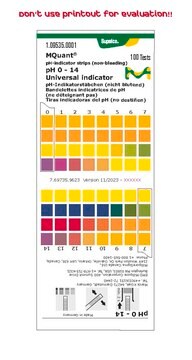1.01322
Methyl orange (C.I. 13025)
pH indicator, ACS, Reag. Ph Eur
Sinónimos:
Methyl orange (C.I. 13025), 4-Dimethylaminoazobenzene-4′-sulfonic acid sodium salt, Gold orange, Helianthine, Orange III
About This Item
Productos recomendados
product name
Methyl orange (C.I. 13025), indicator ACS,Reag. Ph Eur
grade
ACS reagent
Quality Level
agency
reag. Ph. Eur.
form
solid
potency
60 mg/kg LD50, oral (Rat)
loss
≤5% loss on drying, 110°C
pH
6.5 (20 °C, 5 g/L in H2O)
mp
>300 °C
bulk density
200‑400 kg/m3
storage temp.
2-30°C
InChI
1S/C14H15N3O3S/c1-17(2)13-7-3-11(4-8-13)15-16-12-5-9-14(10-6-12)21(18,19)20/h3-10H,1-2H3,(H,18,19,20)/p-1
InChI key
IETWCRRCPURZOC-UHFFFAOYSA-M
Application
- Plant-assisted green preparation of silver nanoparticles using leaf extract of Dalbergia sissoo and their antioxidant, antibacterial and catalytic applications.: This research utilized Methyl Orange as an indicator in the green synthesis of silver nanoparticles using Dalbergia sissoo leaf extract. The study highlighted its catalytic application in dye degradation, demonstrating the environmental benefits of plant-assisted nanoparticle synthesis (Khatun et al., 2024).
- Dye Degradation and Sulfur Oxidation of Methyl Orange and Thiophenol via Newly Designed Nanocomposite GQDs/NiSe-NiO Photocatalyst Under Homemade LED Light.: This study focused on the efficient photocatalytic degradation of Methyl Orange using a novel nanocomposite photocatalyst under LED light, presenting significant advancements in photocatalytic materials for wastewater treatment (Srivastava et al., 2023).
- Bryophyllum pinnatum leaf extract mediated ZnO nanoparticles with prodigious potential for solar driven photocatalytic degradation of industrial contaminants.: The research demonstrated the synthesis of ZnO nanoparticles using Bryophyllum pinnatum leaf extract and their application in the photocatalytic degradation of Methyl Orange, showcasing a sustainable approach to tackling industrial pollutants (Dhiman et al., 2023).
- Light driven Aspergillus niger-ZnS nanobiohybrids for degradation of methyl orange.: This paper explored the use of Aspergillus niger-ZnS nanobiohybrids for the degradation of Methyl Orange, emphasizing the potential of biogenic approaches in enhancing photocatalytic efficiency (Priyanka & Lens, 2022).
- Bacterially driven cadmium sulfide precipitation on porous membranes: Toward platforms for photocatalytic applications.: This study utilized Methyl Orange to assess the photocatalytic efficiency of cadmium sulfide precipitated on porous membranes by bacteria, proposing a novel method for creating photocatalytic platforms for environmental applications (Marusak et al., 2018).
Analysis Note
Appearance of solution: passes test
Loss on drying (110 °C): ≤ 5
Transition range (according to ACS): passes test
Sensitivity test: passes test
signalword
Danger
hcodes
Hazard Classifications
Acute Tox. 3 Oral
Storage Class
6.1C - Combustible, acute toxic Cat.3 / toxic compounds or compounds which causing chronic effects
wgk_germany
WGK 3
flash_point_f
Not applicable
flash_point_c
Not applicable
Certificados de análisis (COA)
Busque Certificados de análisis (COA) introduciendo el número de lote del producto. Los números de lote se encuentran en la etiqueta del producto después de las palabras «Lot» o «Batch»
¿Ya tiene este producto?
Encuentre la documentación para los productos que ha comprado recientemente en la Biblioteca de documentos.
Nuestro equipo de científicos tiene experiencia en todas las áreas de investigación: Ciencias de la vida, Ciencia de los materiales, Síntesis química, Cromatografía, Analítica y muchas otras.
Póngase en contacto con el Servicio técnico







